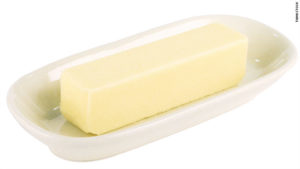
HERBAL BUTTERS Herbal butters are one of my favorite ways to use fresh herbs. It is great on vegetables, bread, pasta and with many foods. The butter can be made with dried or fresh herbs and you can freeze it! You can make a little flower on top with the red blossoms from pineapple sage.
Dried Herbal Butters: Mix 2 teaspoons of the dried herb blend with 1/4 pound of butter and store in refrigerator.
Fresh Herbal Butters: Mix 1/4 cup finely chopped herbs with 1 pound butter. It can be formed into a cylinder when rolled in wax paper. Refrigerate and slice when firm. Fresh butters last for 3-4 months in the freezer or a week in the refrigerator.
Garden Herb Blend: Use for vinaigrettes, dips, and biscuit mixes:
3 parts parsley
1 part thyme
1 part sage
1/2 part garlic granules
1 part rosemary
Lemon Dill Herb Blend: Great on potatoes or in rice. Use in vinaigrettes, dips, marinades and biscuit mixes
4 parts parsley
2 parts dill
1 part lemon rind grated fine
1 part garlic granules
Savory Nasturtium Butter: Slice nasturtium petals into long strips. Mix 1 tbl. Blossoms with 1/2 tsp freshly ground pepper and add to 1/4 lb. Butter.
Butter Super Food
Butter is a healing superfood. It has the highest source of conjugated linoleic acid (CLA), a powerhouse fatty acid. CLA concentration varies with the season. CLA concentration is 4 times higher in summer milk than winter, due to pasture grazing. CLA inhibits cancer, according to one report in the Journal of Nutrition:
“In a number of studies, conjugated linoleic acid, at near-physiological concentrations, inhibited mammary tumorigenesis independently of the amount and type of fat in the diet. “
Additionally, this fatty acid has been shown to inhibit the growth of skin, colon, breast and lung cancer cells. Multiples studies reveal that CLA reduces the size of tumors in lab rats.
These studies show why butter is important for children to eat! CLA fed to rats before the perpubertal period prevented the growth of tumors, but when the rats weren’t fed CLA until maturity, they had to consume the fatty acid for the rest of their life to prevent tumor growth.
Butter contains 4% butyric acid, an anti-carcinogenic short-chain fatty acid. It inhibits the growth of mammary tumors. Butyric acid is a biological response modifier, a substance that arouses the body’s response to infection.
Butter does NOT make you fat. Butter is a rich source of short and medium chain fatty acids, and these molecules “are not deposited to any extent in the adipose tissue”
Butter contains vitamin K2. Weston Price recorded his investigation of this vitamin and found that butter high in K2, combined with “a favorable selection of natural foods” successfully treated tooth decay. Interestingly, the concentration of K2 in butter varied greatly depending on the cow’s food with a prominent increase when the cows were pasture grazing
Scientists continue to explore the importance of K2 in diet. A recent study published by a European nutrition journal showed that an increased consumption of K2 may reduce the risk of prostrate cancer by 35 percent
Butter is packed with Fat-Soluble Vitamins. It is a potent source of vitamins A, D, and E, and the perfect carrier for these vitamins because it provides the fat needed for their absorption. It offers these vitamins to your body in the most assimilable form. In animal sources, vitamin A is a retinol and requires a little work by the body to make this conversion. On the other hand, the body is very inefficient at converting cartenoids from plant sources (like beta-carotene in orange veggies) into useable vitamin A.
